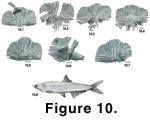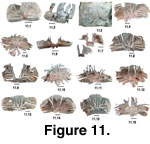 Description
DescriptionEngraulis mordax mordax
(Northern Anchovy)
(Other common names: California Anchovy, Plain Anchovy)
Figure 10.8
 Description
DescriptionLength: up to 23 cm but most are around 18 cm.
Mouth: inferior, large, directed slightly upwards; upper jaw extends back approximately 2.5 times the distance of the tip of the snout to the midorbit point; lower jaw does not quite reach the anterior edge of the orbit; teeth on maxillary and mandibles.
Body: in cross-section is round; opercules prolonged backwards; caudal fin forked; scale-like appendages above and below the midlateral line on fin; fleshy appendages at the insertion of each fin.
Color: metallic blue to green above and silver on lateral and ventral sides.
Depth: pelagic schooling species (sometimes with other schooling species such as herring and mackerel).
Habitat: coastal nearshore waters.
Season: life history in BC not well known; in southern range spawning occurs at night in the upper warm water layers.
Diet: crustaceans (e.g., euphasiids, copepods, decapod larvae).
Predators: larger fish species, marine mammals, sea birds.
Distribution: Baja, California to the Queen Charlotte Islands.
 Scale
Description
Scale
DescriptionRelative Size of Scale: large. The sampling area for the scales illustrated is not known but they all appear to be of a single morphology and size, suggesting that they came from one individual fish.
Position of Scales on Body: in oblique rows on the midside, 41-50 (Hart, 1973).
Overall Scale Shape: the overall shape is circular, the scale is tri-lobed in the anterior field and the posterior field is variable in shape. The posterior fields are heavily subjected to fracturing.
Focus and Circuli: the focus is generally indistinct. The area of growth appears to occur (as seen on scale morphology) as the area of the first concentric continuous circuli and the region posterior to that area, which consists of discontinuous transverse "circuli." This is the region of interface between the anterior/lateral fields and the posterior field. The circuli are continuous between the lateral and anterior field (or the three lobes) and discontinuous in the posterior field. The circuli in the latter field can be indistinct. The continuous circuli are concentric with the outline shape of the scale.
Radii: there are no radii present, however, there are often transverse grooves and fracture lines that occur in predictable ways. Wing joins can fracture both transversely and in the anterior/posterior axis.
 Scale
Preservation
Scale
PreservationScales of the northern anchovy preserve easily in Quaternary sediments. They are robust and have a high degree of mechanical flexibility. They are, however, subject to erosion and fracturing along points of weakness. The degree of abrasion in the sediments controls the degree of fragmentation. Wings (posterior fields) are often disarticulated, as is the central lobe in the anterior field. In some cases, all three lobes and wing are disarticulated, leaving only the central focal area. Care must be taken when determining counts so that a single fragmented scale is not counted several times. The scales are generally amber in color. Some geochemical conditions can "bleach" them white and cause them to become extremely brittle.